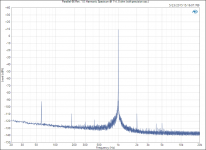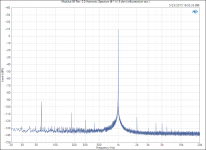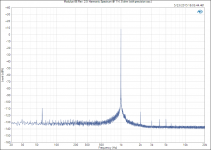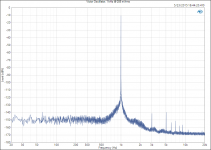Speakers are typically reactive, so the current lags the voltage. This means that when the output voltage passes through zero, Iout will be nonzero. And ohms law says R=Vload/Iload, so at that exact moment the speaker load is zero ohms. Are you going to argue with ohms law now? 😉
No, Ohm's Law still applies. You just have to remember that the (AC) voltage varies as a function of time and the impedance has a phase component. Do the vector math and you can calculate exactly how much the current will lag.
Tom
Andrew, any signal imaginable can be recreated by combining the appropriate sine waves. What you call fast stopping, or fast starting, signals (where does that quote come from?), would be represented by high frequency sine wave components. All drivers exhibit a rising impedance with frequency, so red herring here.
I know [emoji1] that was a bad joke on my part.No, Ohm's Law still applies. You just have to remember that the (AC) voltage varies as a function of time and the impedance has a phase component. Do the vector math and you can calculate exactly how much the current will lag.
Tom
WHERE are these unicorns ... with current draw more than 3x that for the nominal resistive speaker load .. as you claim?The report is linked in a Thread on this Forum.
It is an effect that has been written about many times.
It is an effect that both D.Self and R.Cordell have written about.
The extra current draw of a two way speaker, relative to a resistor load, is well documented.
If you could link to these, at least one (ex?) speaker (pseudo?) guru would be very grateful to be enlightened 🙂
New THD measurements
Folks,
As suggested quite a while ago, I measured the THD using an oscillator that's even better than that of the APx525. The harmonics of the oscillator are a good 140-145 dB down, which makes it possible to get a true THD measurement for the Parallel-86.
The THD at 1 W, 8 Ω, 1 kHz measures 0.00012 % (-119 dB). Note that the oscillator adds a bit of mains hum, hence, the mains components (60, 180, 300, 420 Hz) are a good 10-20 dB higher than the residual mains hum of the amp itself.
Tom
Folks,
As suggested quite a while ago, I measured the THD using an oscillator that's even better than that of the APx525. The harmonics of the oscillator are a good 140-145 dB down, which makes it possible to get a true THD measurement for the Parallel-86.
The THD at 1 W, 8 Ω, 1 kHz measures 0.00012 % (-119 dB). Note that the oscillator adds a bit of mains hum, hence, the mains components (60, 180, 300, 420 Hz) are a good 10-20 dB higher than the residual mains hum of the amp itself.
Tom
Attachments
Last edited:
It must feel good to push the limits of the test set like that. Have you worked out if the 60Hz and harmonics is 'real' or just pickup from around the test bench?
The 60 Hz components seem to come from the 1 kHz oscillator. I'll have to put it into an enclosure and use battery power to get a cleaner FFT.
And yeah... I was pretty thrilled to get the fourth zero on the THD. 😎
Tom
And yeah... I was pretty thrilled to get the fourth zero on the THD. 😎
Tom
...and now battery powered. Same 0.000067 % THD.
I suspect the remaining 60 Hz is a ground loop. The grounding of that oscillator could be better. The hash in the noise floor below 1 kHz and the slightly higher noise floor below 1 kHz are caused by the oscillator as well.
Tom
I suspect the remaining 60 Hz is a ground loop. The grounding of that oscillator could be better. The hash in the noise floor below 1 kHz and the slightly higher noise floor below 1 kHz are caused by the oscillator as well.
Tom
Attachments
Last edited:
Tom,
Would you expect the modulus 86 revision 1 specs to be the same as revision 2 with regards to the THD levels you posted recently?
Thanks,
Anand.
Would you expect the modulus 86 revision 1 specs to be the same as revision 2 with regards to the THD levels you posted recently?
Thanks,
Anand.
Here's the precision oscillator I used. I think it's from a DIY Audio member, actually. I found it on eBay (following the recommendations of a DIYA member).
The THD in this measurement is limited by the THD of the ADC of the APx525 (-130 dB THD). To measure the THD of the oscillator itself, a precision notch filter is needed to reduce the 1 kHz fundamental. I've seen measurements done this way that back up Victor's claims of harmonics below -145 dBc.
Tom
The THD in this measurement is limited by the THD of the ADC of the APx525 (-130 dB THD). To measure the THD of the oscillator itself, a precision notch filter is needed to reduce the 1 kHz fundamental. I've seen measurements done this way that back up Victor's claims of harmonics below -145 dBc.
Tom
Attachments
Probably even lower because of lacking emf.
You mean Back-EMF I suppose? Back-EMF only plays a role around Fs regarding impedance.
Reading this threat it is more an exercise in numbers. And with 100 tons you get every dog flat. But is it still a nice dog?
Translation: Does idiotic low distortion numbers by huge amounts of feedback, make a fine amplifier? And even more lower numbers a finer amplifier?Sorry not sure I understand what you are saying here.
You mean Back-EMF I suppose? Back-EMF only plays a role around Fs regarding impedance.
Reading this threat it is more an exercise in numbers. And with 100 tons you get every dog flat. But is it still a nice dog?
There is always back emf, happy for you that you understand shorthand. It just maxes out at Fs because movement is largest, but it is always there when the vc moves. As in when the driver is producing sound.
All other things being equal, lower distortion is always better, or do you have moral objections against using as much feedback as you can?
Last edited:
Translation: Does idiotic low distortion numbers by huge amounts of feedback, make a fine amplifier? And even more lower numbers a finer amplifier?
Well I disagree with 'idiotic'. Trying to make something better is generally laudable. Whether it sounds noticably different from an amplifier with 0.1% THD in a blind test I don't know, but all the current evidence (rather than anecdote) would suggest that low distortion is a good thing.
Also note the latest improvement was entirely down to improving the test set rather than the circuit.
Ask Bruno Putzeys? linkTranslation: Does idiotic low distortion numbers by huge amounts of feedback, make a fine amplifier? And even more lower numbers a finer amplifier?
- Home
- Vendor's Bazaar
- Modulus-86: Composite amplifier achieving <0.0004 % THD+N.



